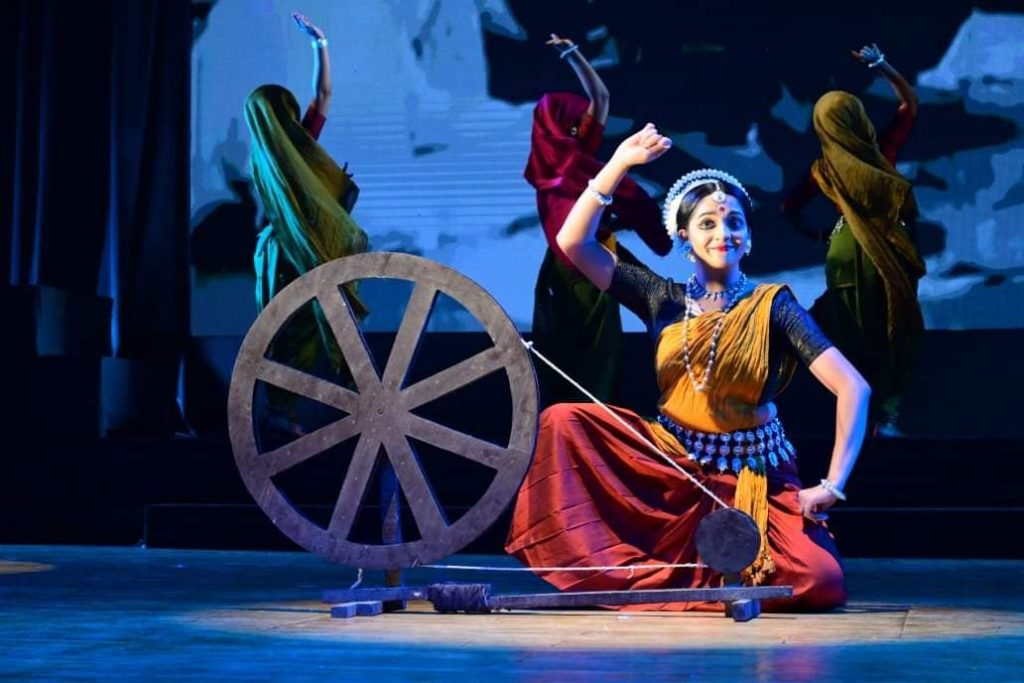I am not here to write a review of a dance festival. It has really become a cliché to talk about festivals, naming the dance productions and their details and mostly to be appreciative and a little bit of criticism. Nowadays, I choose my bit of interest and pick up what I love the most at a festival.
During Raja, the festival of fertility in Odisha, a different kind of festival was staged at Rabindra Mandap to celebrate the life and contribution of national heroes on the 75th year of India’s independence. The three days festival was lined up with six dance dramas (all in Odissi dance), from June 15-17. The event organised by Odisha Sangeet Natak Academy was indeed a well-curated one as it focused on a particular theme and celebrated the idea of freedom.
Somehow, my writing is not about the festival as a whole. I have picked my favourites and would elaborate on that particular choreography.

The spirit of freedom and the persona of Mahatma Gandhi merged with each other and emerged as an inseparable whole which is called the Indian freedom struggle. In Gandhi’s lifetime and long after he is gone, he remains one of the most revered (of course cursed by a few also) political thinkers of our time. Personally for me thinking about Gandhi makes me cry. Writing a pretty long dance drama of 50 minutes on Gandhi for Aruna Mohanty, the renowned Odissi diva was a process of deep emotional attachment with Gandhi, his life, his ideas and his time.
The conception of that script and its adoption in Odissi form hunts me since the day of its first presentation. Writing about the apostle of peace and nonviolence in a troubled time like this makes my mind stormy. I vividly remember the first day when the dance drama ‘Mahatma’ was presented at Xavier’s University five years ago by Orissa Dance Academy. On that day, I had a serious eye infection. As tears rolled down my eyes all through the dance drama, I thought (or pretended) it was due to my eye infections.
Again, after five years, when I saw the ‘Mahatma’ at Rabindra Mandap during the “Azadi” festival on the evening of June 15, I had the same emotional outburst. My eyes were in perfect shape on that day. I tried to hide my tears and pretended not to be affected by a dance drama, but I failed. I am happy that I did fail.

I don’t know who makes me weep, Gandhi himself, the poems I picked on Gandhi, the time and struggle of the Mahatma or the art of Gandhian spirit in Odissi dance. I am a hard-nosed critic, so it’s unusual for me to cry for a dance number. Confession of being so emotionally affected by a dance production is too bad for a dance critic. Somehow it’s more honest to say what you really feel to say.
Mahatma is not based on the biographical narrative, rather it talks more about the relevance of Gandhi today. In a world, deeply wounded by terrorism, intolerance and communal bigotry what relevance does Gandhi has today- that’s the question the choreographer puts forward. Gandhi’s journey from a political leader to the spiritual mentor of humanity has been narrated in the choreography underlining a few important snippets of his life. Aruna Mohanty crafted the choreography in such a way that it speaks more than what it shows. It’s not a mere dance translation of poetic narrative, but rather the vision of the choreographer’s creativity and imagination. The use of Gandhi’s stick and its sound take the message to a level of artistic brilliance where sounds surpass the meanings and messages.

Musically ‘Mahatma’ is a marvellous piece created by the great Guru Ramahari Das. The maestro’s crystal clear musical scores give plentiful space for the choreographer to artistically play with the narrative and to create an aesthetic superstructure.


